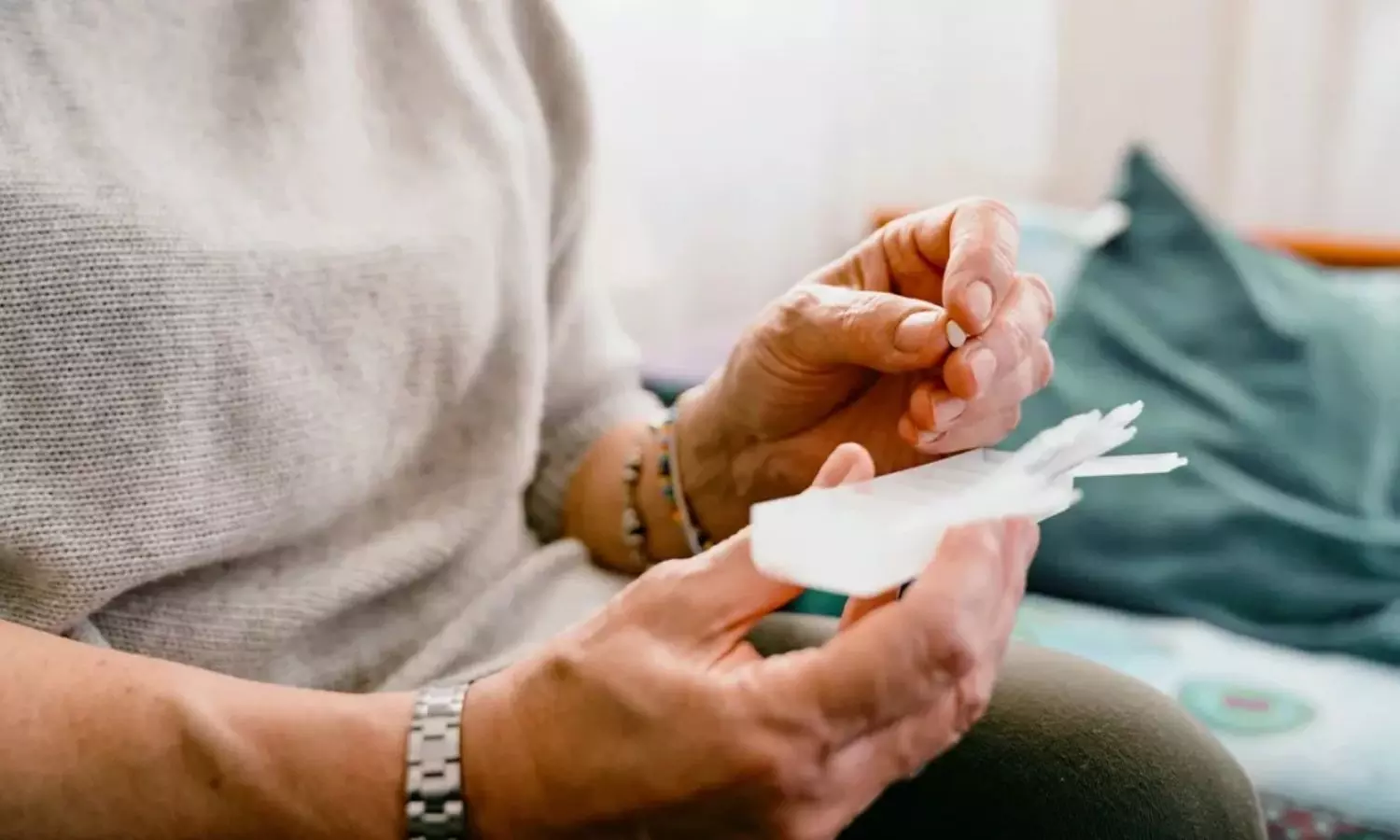Analysis of 26 countries reveals suicide risk highest on Mondays and New Year’s Day
Powered by WPeMatico
Powered by WPeMatico
Powered by WPeMatico
Powered by WPeMatico

Auraiya: In a shocking incident, the wife of a Deputy Chief Medical Officer (Dy CMO) was found dead under mysterious circumstances at their government residence in the Ajitmal area of Auraiya district in Uttar Pradesh on Wednesday.
Police sources said that Dy CMO Dr Vikarm Swaroop is posted at Ajitmal Community Health Centre (CHC). “He was living on the second floor of the official residence with his second wife Srishti Singh (46)”.
According to a UNI report, police sources said on Wednesday Dr Vikram Swaroop informed the police that his wife had committed suicide. “When the police reached the spot, Shrishti’s body was lying on the ground and there were injury marks on her head. Blood was spilled on the floor of the room, her bangles were also broken, and a slipper and a syringe and needle were lying nearby,” they said.
As per a media report in the TOI, Srishti was in poor health for some time, which had impacted her mobility. On Wednesday, Dr Vikram Swaroop called the police and reported that his wife died by suicide. When the police arrived at the scene, they found Srishti’s body on the ground with injury marks on her body.
Police said the cause of death would become clear after the post-mortem report is received. “The police are investigating the matter from all angles,” Police said.
Also Read:Maharashtra Shocker: Doctor ends life after harassment from husband in-laws over Rs 1 cr demand
Powered by WPeMatico

 Panchkula: In a recent snatching incident, a Panchkula-based doctor lost her gold pendant to a bike-borne miscreant on Monday morning.
Panchkula: In a recent snatching incident, a Panchkula-based doctor lost her gold pendant to a bike-borne miscreant on Monday morning.
The theft occurred at 8:42 a.m. on Monday in Sector 10 while Dr Sikha was dropping her son off at school. As she was leaving, an unknown assailant approached on a motorcycle and snatched the pendant before fleeing the scene.
The doctor has filed a complaint against the snatcher with the local police. According to the complaint, the snatcher was riding a motorcycle and approached her from behind. She described that the accused snatcher was wearing a purple-pink kurta-pajama with a bag on his back.
The incident happened near Toddler World School, Sector 10, where the suspect attempted to snatch her gold chain.
Also Read: Madhya Pradesh: Doctor’s laptop bag stolen from car, FIR lodged
Dr Shikha resisted, managing to retain the chain. However, during the struggle, the chain broke, and the snatcher was able to make off with the pendant which weighed around 2.5 to 3 grams. Authorities are now conducting further investigations to identify and apprehend the suspect. This snatching incident which occurred in broad daylight, raised concerns about safety in the area.
As per a recent media report by Hindustan Times, in response to Dr Shikha’s complaint, the police have registered a case under Section 304 of the Bharatiya Nyaya Sanhita (BNS) and further investigations are on.
Also Read: Haryana Doctor robbed of Rs 15 lakh cash, jewellery by masked men at gunpoint
A similar case was reported by Medical Dialogues where a visit to a paediatrics conference in Gandhinagar turned detrimental for a Telangana-based doctor couple who lost Rs 1.90 lakh on the morning of 22nd February in an alleged case of purse snatching. The incident took place when the couple was inside an autorickshaw in the Raipur area. The doctor eventually filed a complaint at the Khadia police station, based on which an FIR was registered.
Powered by WPeMatico

Nagpur: Doctors at Max Super Speciality Hospital, Nagpur successfully performed a rare and complex primary hip replacement surgery on a 32-year-old patient post a road traffic accident. A team of doctors, led by Dr Manoj Pahukar, the Director of Joint Replacement & Orthopaedics at Max Super Speciality Hospital, Nagpur, helps the man walk again.
Powered by WPeMatico

USA: The recent analysis from the VICTORIA trial has highlighted the potential benefits of vericiguat in managing cardiovascular (CV) outcomes for patients suffering from heart failure (HF), particularly those with varying diabetes statuses.
The post hoc analysis, published in JACC: Heart Failure, revealed that vericiguat, when compared to a placebo, significantly decreased the risk of cardiovascular death or heart failure hospitalization (HFH) in patients with worsening heart failure with reduced ejection fraction, irrespective of whether they had type 2 diabetes mellitus (T2DM).
Heart failure remains a major public health challenge, particularly among individuals with diabetes. As diabetes exacerbates the risk of cardiovascular complications, understanding effective treatments for heart failure in this demographic is critical. Considering this, Paul W. Armstrong, Canadian VIGOUR Centre, University of Alberta, Edmonton, Canada, and colleagues aimed to examine the influence of type 2 diabetes mellitus on outcomes for patients enrolled in the VICTORIA trial and evaluate the efficacy of vericiguat in both T2DM and non-T2DM patients.
For this purpose, the researchers randomized patients with heart failure and reduced ejection fraction to receive either vericiguat or a placebo alongside standard therapy. The primary outcome measured was a composite of cardiovascular death or the first heart failure hospitalization. To determine whether the effect of vericiguat varied based on a history of type 2 diabetes, a Cox proportional hazards model was utilized to calculate hazard ratios (HRs).
Based on the study, the researchers revealed the following findings:
The study found that over 80% of patients had either type 2 diabetes or pre-diabetes, highlighting the high prevalence of glycemic issues among those with heart failure with reduced ejection fraction. Notably, about 5% of patients were found to have undiagnosed T2DM at the time of screening, emphasizing the need for more thorough screening for T2DM in patients experiencing worsening HFrEF.
“In terms of treatment, vericiguat significantly reduced the risk of cardiovascular death or heart failure hospitalization compared to placebo, and this benefit was observed regardless of the patients’ T2DM status. However, vericiguat had minimal impact on body mass index and HbA1c levels overall, and it did not significantly influence the initiation of insulin or other blood sugar-lowering medications,” the researchers wrote.
Reference:
Khan, M. S., Butler, J., Young, R., Lewis, B. S., Escobedo, J., Refsgaard, J., Reyes, E., Roessig, L., Blaustein, R. O., Lam, C. S., Voors, A. A., Ponikowski, P., Anstrom, K. J., & Armstrong, P. W. (2024). Vericiguat and Cardiovascular Outcomes in Heart Failure by Baseline Diabetes Status: Insights From the VICTORIA Trial. JACC: Heart Failure, 12(10), 1750-1759. https://doi.org/10.1016/j.jchf.2024.05.007
Powered by WPeMatico

USA: A recent analysis from the ONWARDS clinical trials has revealed significant improvements in treatment satisfaction among individuals with Type 2 diabetes using once-weekly insulin icodec compared to traditional once-daily basal insulin. The findings underscore the potential benefits of this innovative treatment regimen in enhancing patient adherence and overall management of the condition.
“These findings indicate a higher level of treatment satisfaction and a clear preference for once-weekly insulin over the traditional once-daily basal insulin. The convenience of this regimen, along with patients’ willingness to continue and recommend once-weekly treatment, was notably emphasized,” the researchers wrote in Diabetes Research and Clinical Practice.
The study, which included patient-reported outcomes from ONWARDS 2 and 5, and physician surveys from ONWARDS 1, focused on the experiences of patients switching to insulin icodec. The ONWARDS phase 3a clinical trials compared the efficacy of once-weekly insulin icodec with once-daily basal insulin in individuals with type 2 diabetes. The analysis by William Polonsky, Behavioral Diabetes Institute, San Diego, CA, USA, and colleagues investigated the treatment-related experiences of participants from ONWARDS 5 and 2, and physicians from ONWARDS 1.
For this purpose, the researchers collected patient-reported outcomes exclusively during ONWARDS 5, which compared insulin icodec with a dosing guide app against once-daily basal analogs, and ONWARDS 2, which examined icodec versus once-daily insulin degludec. Additionally, treatment preferences and satisfaction from physicians participating in ONWARDS 1, where icodec was compared to once-daily insulin glargine U100, were gathered through an online survey.
The following were the key findings of the study:
The findings from insulin-naive and insulin-experienced participants with type 2 diabetes in the ONWARDS 5 and ONWARDS 2 trials, along with feedback from physicians in ONWARDS 1, reveal significant improvements in treatment satisfaction. Participants showed a strong preference for once-weekly basal insulin, leading to better adherence to treatment.
“These results highlight the potential for personalized approaches in diabetes care, making once-weekly insulin a viable option for individuals with type 2 diabetes,” the researchers concluded.
Reference:
Polonsky, W., Benamar, M., Carstensen, L., Davies, M., Meller Donatsky, A., Franek, E., Kellerer, M., Philis-Tsimikas, A., & Goldenberg, R. (2024). Improved treatment satisfaction with once-weekly insulin icodec compared with once-daily basal insulin in individuals with type 2 diabetes: An analysis of patient-reported outcomes and participant interviews from ONWARDS 2 and 5 and a physician survey from ONWARDS 1. Diabetes Research and Clinical Practice, 217, 111885. https://doi.org/10.1016/j.diabres.2024.111885
Powered by WPeMatico

Acupuncture alleviates pain and improves function among patients with chronic sciatica from herniated disk suggests a new study published in the JAMA.
Sciatica is commonly caused by herniated lumbar disc and contributes to severe pain and prolonged disability. Although acupuncture is widely used by patients with chronic sciatica, the evidence of its efficacy is scarce.
A study was done to investigate the efficacy and safety of acupuncture compared with sham acupuncture in patients with chronic sciatica from herniated disk. This was a multicenter 2-arm randomized clinical trial conducted in 6 tertiary-level hospitals in China of patients with chronic sciatica from herniated disk. Participants were recruited from March 25, 2021, to September 23, 2021, with a final follow-up through September 22, 2022. Data analyses were performed from December 2022 to March 2023. Participants were randomly assigned to receive 10 sessions of acupuncture (n = 110) or sham acupuncture (n = 110) over 4 weeks. Participants, outcome assessors, and statisticians were blinded. The 2 coprimary outcomes were changes in visual analog scale (VAS) for leg pain and Oswestry Disability Index (ODI) from baseline to week 4. Secondary outcomes were adverse events. Results: A total of 216 patients (mean [SD] age, 51.3 [15.2] years; 147 females [68.1%] and 69 males [31.9%]) were included in the analyses. The VAS for leg pain decreased 30.8 mm in the acupuncture group and 14.9 mm in the sham acupuncture group at week 4 (mean difference, −16.0; 95% CI, −21.3 to −10.6; P < .001). The ODI decreased 13.0 points in the acupuncture group and 4.9 points in the sham acupuncture group at week 4 (mean difference, −8.1; 95% CI, −11.1 to −5.1; P < .001). For both VAS and ODI, the between-group difference became apparent starting in week 2 (mean difference, −7.8; 95% CI, −13.0 to −2.5; P = .004 and −5.3; 95% CI, −8.4 to −2.3; P = .001, respectively) and persisted through week 52 (mean difference, −10.8; [95% CI, −16.3 to −5.2; P < .001; and −4.8; 95% CI, −7.8 to −1.7; P = .003, respectively). No serious adverse events occurred. This randomized clinical trial found that in patients with chronic sciatica from herniated disk, acupuncture resulted in less pain and better function compared with sham acupuncture at week 4, and these benefits persisted through week 52. Acupuncture should be considered as a potential treatment option for patients with chronic sciatica from a herniated disk.
Reference:
Tu J, Shi G, Yan S, et al. Acupuncture vs Sham Acupuncture for Chronic Sciatica From Herniated Disk: A Randomized Clinical Trial. JAMA Intern Med. Published online October 14, 2024. doi:10.1001/jamainternmed.2024.5463
Keywords:
Acupuncture, alleviates, pain, improves, function, among, patients, chronic, sciatica, herniated, disk, JAMA, Tu J, Shi G, Yan S
Powered by WPeMatico

The lifetime risk of an unexpected and sudden death from a cardiovascular cause in the absence of pre-existing heart disease-known as sudden cardiac death-is more than 4 times higher for people with schizophrenia than it is for the general population, indicates Danish research published online in the journal Heart.
The risk is still around twice as high for those with other types of mental ill health, such as depression, whatever their age, indicate the findings, which suggest that an 18 year old can expect to live around 10 fewer years than someone of the same age without mental health issues.
The research to date indicates that young people with a psychiatric illness are at heightened risk of sudden cardiac death, but it’s not clear if that risk extends across the lifespan or if particular mental health disorders are associated with greater risk.
To find out, the researchers systematically reviewed all deaths occurring in 18 to 90 year old Danish residents over the course of 2010, drawing on information from death certificates and post mortem reports.
Mental health disorders within the previous 10 years were defined according to International Classification of Diseases criteria or by prescriptions for psychotropic drugs filled within the preceding year.
During the course of 2010, 45,703 people between the ages of 18 and 90 died. In all, 6002 of these deaths were classified as sudden cardiac deaths: 3683 in the general population and 2319 among those with a mental illness.
People with mental health disorders tended to have a range of potentially influential risk factors. They tended to be older, female, and were more likely to have co-existing conditions, such as cardiovascular disease, heart failure, arrhythmias, and diabetes.
Overall, the number of cases of sudden cardiac death was up to 6.5 times higher among those with mental health disorders than it was in the general population. While cases were higher in all age groups, the gap narrowed in the oldest age groups.
After taking account of age, sex, and coexisting conditions, mental ill health was nevertheless independently associated with a doubling in the risk of sudden cardiac death.
The risk was twice as high in people with depression, 3-fold higher among those with bipolar disorder, and 4.5 times higher risk among those with schizophrenia.
Mental health disorders were also significantly associated with death from other causes–almost 3 times the risk–and with a shortened lifespan.
Based on the findings, the researchers estimated that an 18 year-old with any type of psychiatric disorder might expect to live around 10 fewer years than someone of the same age without any of these conditions-68 instead of 78.
And they estimated that a 70 year-old might expect to live another 10 years compared with 14 more years in the general population.
Up to the age of around 40, sudden cardiac death explained around 13% of the discrepancy in reduced longevity.
This is an observational study, and therefore no firm conclusions about causal factors can be drawn, caution the researchers.
People with psychiatric disorders are more likely to have an unhealthy lifestyle, and one of the side effects of the medications prescribed is weight gain-all factors that predispose to the development of conditions, such as high blood pressure and heart disease, explain the researchers.
But the fact that the association between mental health disorders and sudden cardiac death remained, even after adjusting for these influential factors “suggests that comorbidities, such as cardiovascular disease, are not the only mediators contributing to the higher risk of [sudden cardiac death],” they write.
In a linked editorial, Drs Aapo Aro and Jarkko Karvonen of Helsinki University Hospital, say that while the research “significantly enhances our understanding of [sudden cardiac death] risk within the vulnerable population of psychiatric patients,” its design means that “the underlying mechanisms behind [sudden cardiac death] remain largely speculative.”Heart
Sudden cardiac death is preceded by symptoms in around half of those affected. “If these symptoms are not ignored but acted on promptly, this translates into fivefold increased survival after cardiac arrest,” they explain.
Detecting and acting on these symptoms in those who are mentally ill may be even more difficult than in other groups of patients, they add, but suggest that in the not so distant future AI and wearable electronic devices might be able to identify those most at risk, and potentially save their lives.
Reference:
https://heart.bmj.com/lookup/doi/10.1136/heartjnl-2024-324092
Powered by WPeMatico
